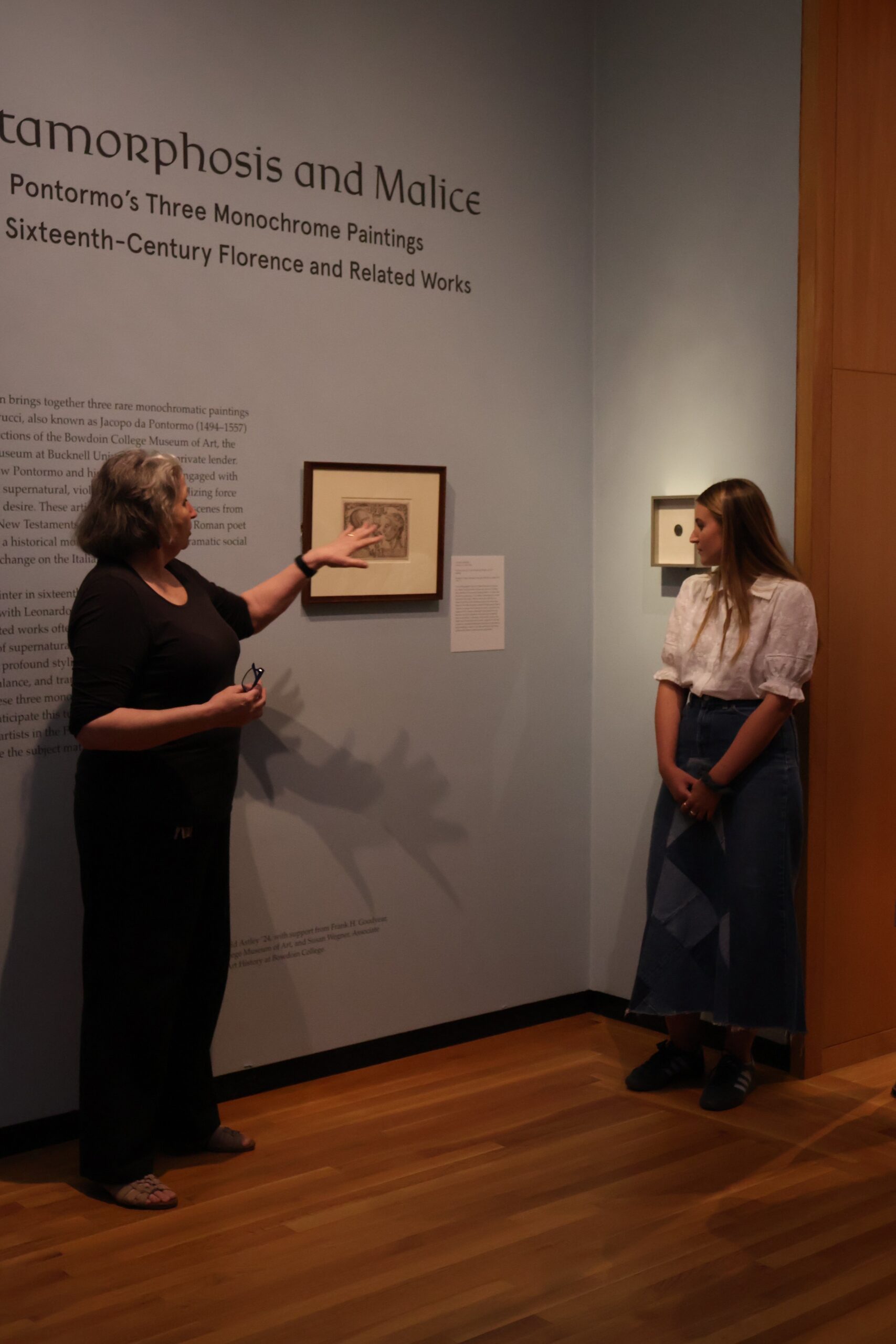“Metamorphosis and Malice” brings Florentine paintings and modern perspectives to the BCMA
September 8, 2023
 Amira Oguntoyinbo
Amira OguntoyinboLast month, the Bowdoin College Museum of Art (BCMA) unveiled a new exhibition, “Metamorphosis and Malice: Pontormo’s Three Monochrome Paintings from Renaissance Florence and Related Works.”
The exhibition is the first time that all three known monochromatic paintings of Jacopo Da Pontormo—a leading painter in sixteenth century Florence—have been shown together. The BCMA hosted a gallery talk on the exhibit yesterday, where student curator Ingrid Astley ’24 and Associate Professor of Art History Emerita Susan Wegner spoke about the exhibition.
The exhibit combines the three oil paintings: “Apollo and Cupid,” “Daphne and Apollo” and “Adam and Eve with Cain and Abel,” all completed between 1513 and 1515, and more works centered around Ovid’s “Metamorphosis.”
“The gallery is a snapshot of this specific time in history—16th century—specifically Florentine art, and [it] also showcases Pontormo’s art. He was one of the leading artists of that century and was an apprentice to Andrea del Sarto and Leonardo da Vinci,” Astley said. “Pontormo is known for his more colorful works, so it’s interesting that these are all in black and white and showcasing the body.”
In the 16th century, Pontormo’s oil paintings were displayed by the House of Medici at public carnivals and on their chariots. They represented the return of the Medici dynasty as the ruling family of Florence in 1512.
“These paintings were done within a political context,” Wegner said at the talk. “Florence reopened their gates to the Medicis after the short exile of their family.”
The ties to the dynasty were evident in the works. In “Apollo and Cupid,” Cupid shoots Apollo, causing him to fall in love with Daphne. In “Daphne and Apollo,” Daphne is being chased by the Greek god Apollo. Daphne asks her father, a river god, to save her, and he turns her into a laurel tree. The laurel tree was a long-held emblem of the Medici family.
“I was thinking, why did the Medici family specifically want to have this story advertised on their chariots? The laurel tree is where I started,” Astley said in yesterday’s discussion. “I was fascinated by the gender and power dynamic of that situation and how Daphne is being literally objectified…. I was interested in the complexity of the story and its metamorphosis. In the painting, you can see Apollo and Daphne are mirrored in this dancer-like stance. It’s very graceful and subtracts from the more violent narrative of consent.”
The gallery begins with a background on the Medicis and with “Scenes from Boccaccio’s ‘Il Ninfale Fiesolano’” by Fra Angelico, painted in 1415. The painting depicts a young shepherd pursuing a nymph in the entourage of the goddess Diana. Although this work dates from a century earlier than Pontormo’s paintings, it is one of Astley’s favorites in the exhibit.
“There are lots of connections between [Pontormo and Angelico], not only showing how painting developed over this time period, but also the narrative arc and the themes of transformation and the conquest of the female body,” she said.
Astley chose to also include the poem “Daphne” by Edna St. Vincent Millay, which was written in 1920.
“I think they’re actually really relevant to contemporary society because of their connection to sexual violence…. I chose to have a poem by Edna St. Vincent Millay, who is a 20th century poet. She’s from Maine, so that’s part of the connection. She tells the story in her poem of the work through Daphne’s perspective, and often everything is through the male perspective—Apollo’s perspective—so I think that made the work more relevant.”
Attendee Steve Cerf ’71 appreciated learning about the context of Pontormo’s paintings.
“It was interesting thinking of Daphne and her agency and her perspective. It was one of the highlights,” Cerf said. “Another thing I loved about the exhibit is the variety. We had the paintings, we had the ancient coins and we had the poem.”
The exhibit is in the BCMA’s Markell Gallery and will run through December 17.
Jane Olsen contributed to this report.

Comments
Before submitting a comment, please review our comment policy. Some key points from the policy: